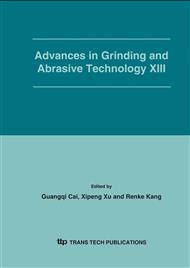p.266
p.271
p.276
p.281
p.286
p.290
p.295
p.300
p.305
Molecular Dynamics Analyze on Effects of Abrasive Size and Cut Depth on the Monocrystal Silicon Grinding
Abstract:
Molecular dynamics (MD) simulation is carried out to analyze the effects of abrasive ngrain size and cut depth on monocrystal silicon grinding process. Tersoff potential is used to describe the interactions of diamond and silicon atoms. Based on classical Newtonian mechanics law, the motion equations of atoms are established and the trajectory of each atom in phase space is obtained with the aid of Velocity Verlet algorithm. Debye model is introduced to convert between kinetic energy and temperature of an atom. The grinding processes of by single grain with different size and different cut depth are investigated in atomic space. Through comparing shearing force and potential energy in the single grain grinding process, the effects of cut depth and grain size on the grinding process are discussed. From the results of MD simulation, it is revealed that when the cut depth increases, both the shearing force in silicon crystal and potential energy between the silicon atoms rise, deformation and dislocations in the silicon lattices increase. As a result, all theses lead to^more severe surface and subsurface damage. With the decreasing of grain size in the same cut-depth nanometric grinding processes, the shearing force in silicon crystal and potential energy between the silicon atoms become larger, deformation and dislocations in the silicon lattices increase.
Info:
Periodical:
Pages:
286-289
Citation:
Online since:
February 2006
Authors:
Price:
Сopyright:
© 2006 Trans Tech Publications Ltd. All Rights Reserved
Share:
Citation:


